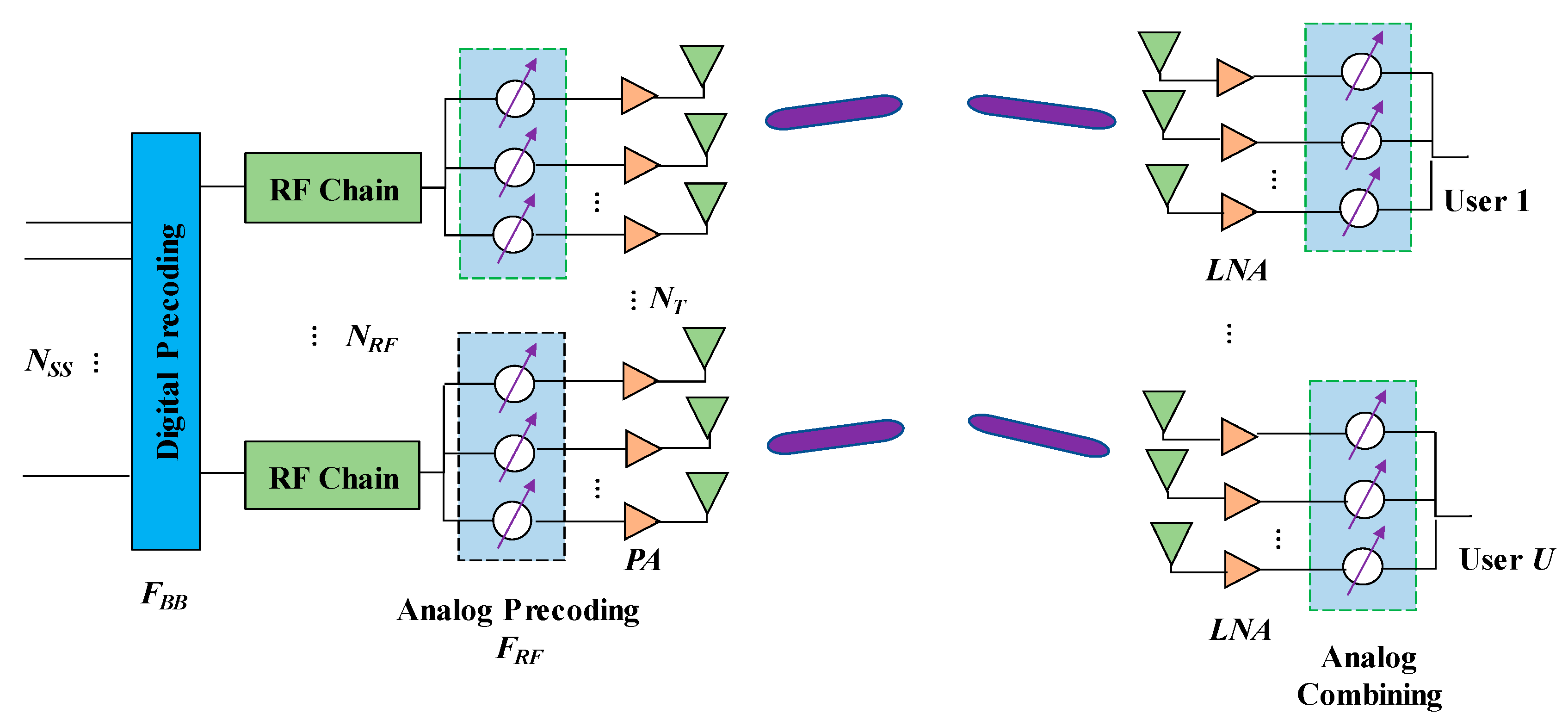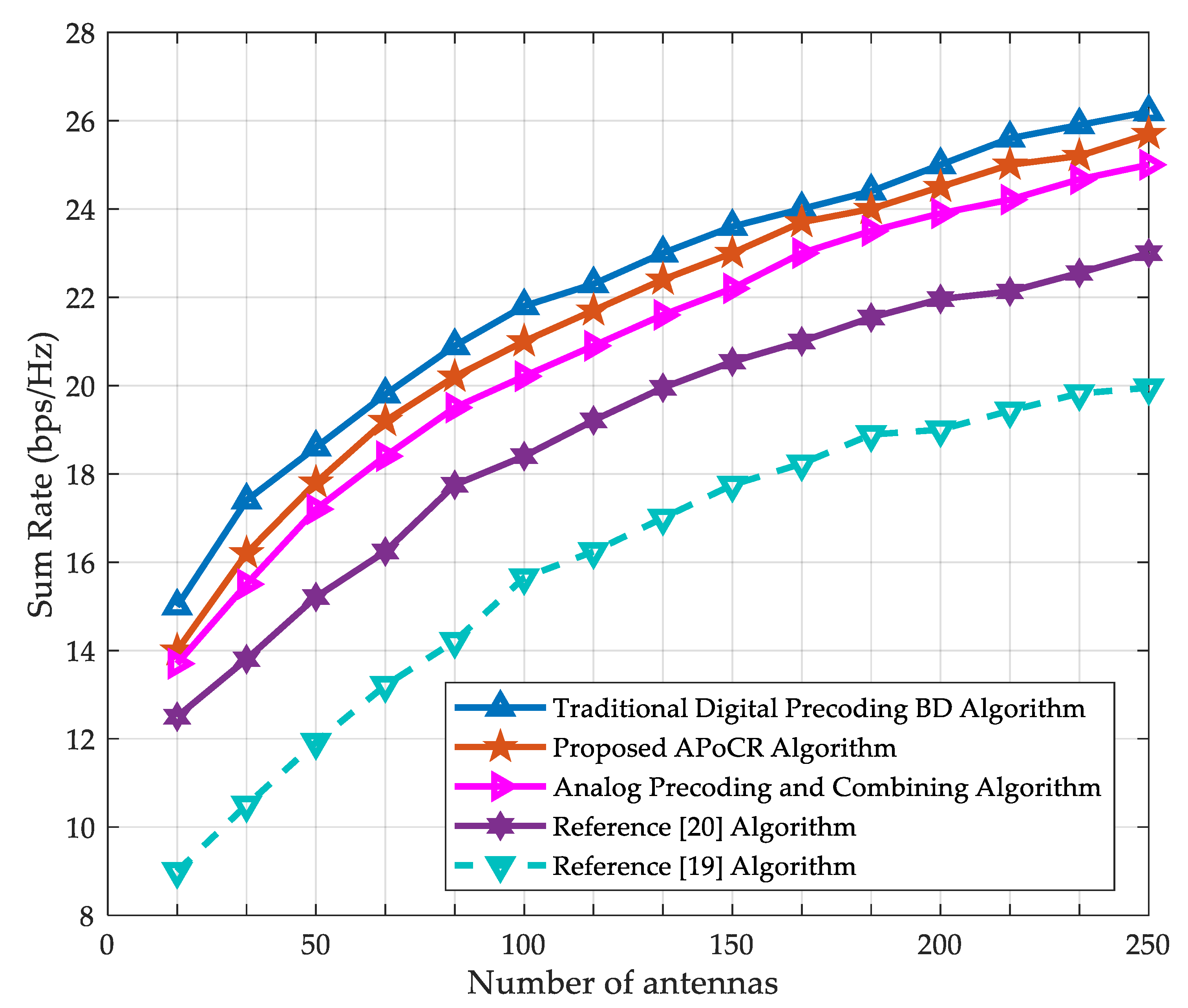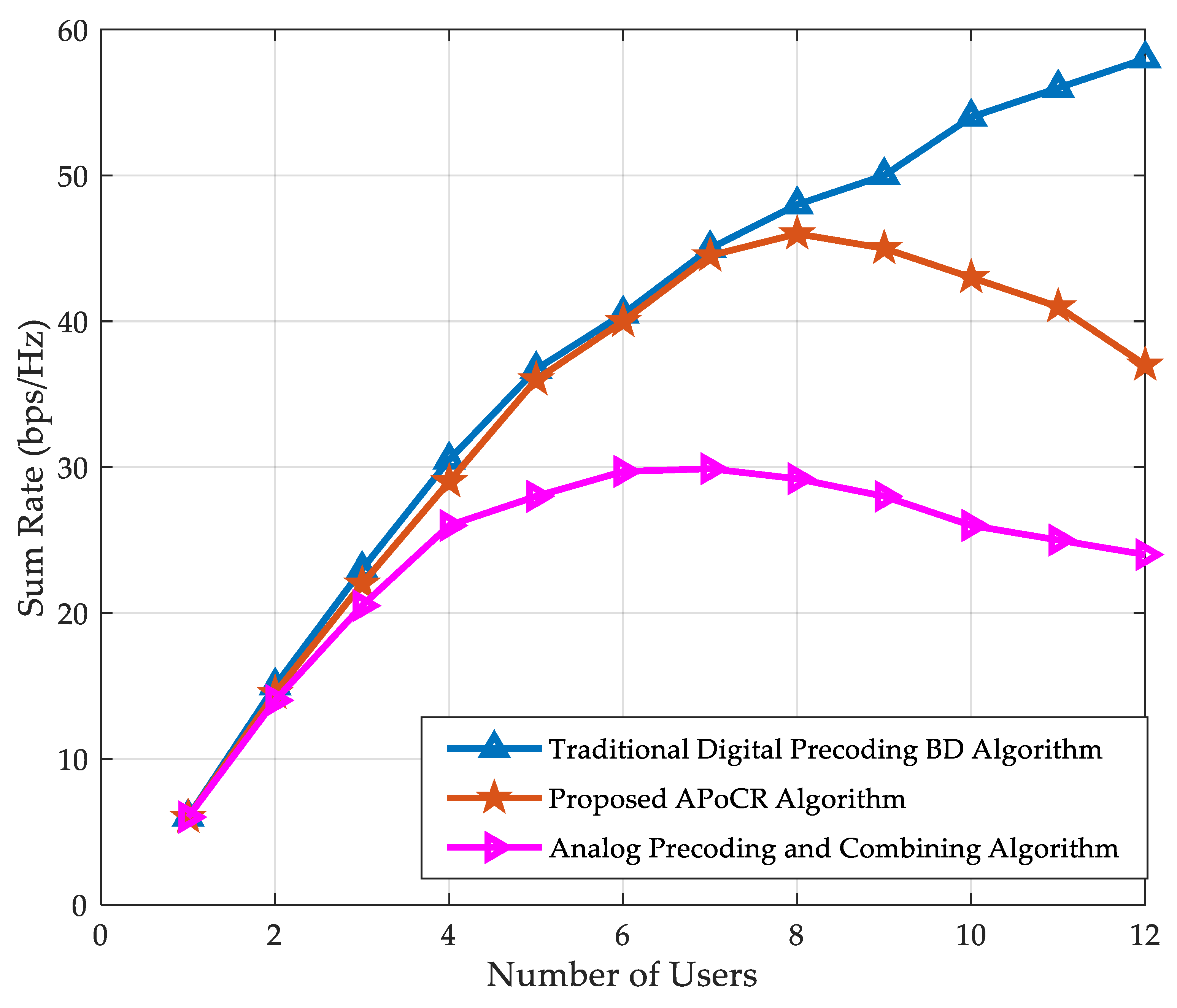An Efficient Algorithm for mmWave MIMO Systems
Abstract
:1. Introduction
2. System Model
2.1. Transceiver Architecture
2.2. Channel Model
3. Proposed Algorithm
| Algorithm 1 APoCR Algorithm |
 |
4. Numerical Simulation Analysis
4.1. Comparison Plan
- (1)
- The traditional pure digital precoding BD algorithm; the number of RF links of the base station is equal to its number of transmitting antennas;
- (2)
- The hybrid precoding algorithm based on continuous interference cancellation proposed in [19];
- (3)
- In the single-user scenario described in [20], the codebook-based transceiver terminal array random matching algorithm;
- (4)
- Analog precoding and combining, regardless of eliminating inter-user interference (IUI) in the digital domain.
4.2. Algorithm Simulation Analysis
5. Conclusions
Author Contributions
Funding
Acknowledgments
Conflicts of Interest
References
- Semiari, O.; Saad, W.; Bennis, M.; Debbah, M. Integrated millimeter-wave and Sub-6 GHz wireless networks: A roadmap for joint mobile broadband and ultra-reliable low-latency communications. IEEE Wirel. Commun. 2019, 26, 109–115. [Google Scholar] [CrossRef]
- Shi, J.; Lv, L.; Ni, Q.; Pervaiz, H.; Paoloni, C. Modeling and analysis of point-to-multipoint millimeter wave backhaul networks. IEEE Trans. Wirel. Commun. 2019, 18, 268–285. [Google Scholar] [CrossRef]
- Wang, T.; Li, G.; Ding, J.; Miao, Q.; Li, J.; Wang, Y. 5G Spectrum: Is China ready? IEEE Commun. Mag. 2015, 53, 58–65. [Google Scholar] [CrossRef]
- Saraereh, O.A.; Khan, I.; Alsafasfeh, Q.; Alemaishat, S.; Kim, S. Low-Complexity Channel Estimation in 5G Massive MIMO-OFDM Systems. Symmetry 2019, 11, 713. [Google Scholar] [CrossRef]
- Elkhashlan, M.; Duong, T.Q.; Chen, H.H. Millimeter-wave communications for 5G-Part 2: Applications. IEEE Commun. Mag. 2015, 53, 166–167. [Google Scholar] [CrossRef]
- Yu, H.; Yang, G.; Meng, F.; Li, Y. Performance analysis of MIMO system with single RF Link based on switched parasitic antenna. Symmetry 2017, 9, 304. [Google Scholar] [CrossRef]
- Al-Sharif, M.H.; Kelechi, A.H.; Kim, J.; Kim, J.H. Energy efficiency and coverage trade-off in 5G for eco-friendly and sustainable cellular networks. Symmetry 2019, 11, 408. [Google Scholar] [CrossRef]
- Yu, H.; Yang, G.; Li, Y.; Meng, F. Design and analysis of multiple-input multiple-output radar system based on RF single-link technology. Symmetry 2018, 10, 130. [Google Scholar] [CrossRef]
- Deong, L.; Zhao, H.; Chen, Y.; Chen, D.; Wang, T.; Lu, L.; Zhang, B.; Hu, L.; Gu, L.; Li, B.; et al. Introduction on IMT-2020 5G Trials in China. IEEE J. Sel. Areas Commun. 2017, 35, 1849–1866. [Google Scholar] [CrossRef]
- IEEE Std 802.15.3c-2009. Wireless MEDIUM ACCESS CONTROL (MAC) and Physical Layer (PHY) Specifications for High Rate Wireless Personal Area Networks (WPANs); IEEE Standards Association Press: Piscataway, NJ, USA, 2009; Volume 49, pp. 114–121. [Google Scholar]
- IEEE P802.11ad. Wireless LAN Medium Access Control (MAC) and Physical Layer (PHY) Specifications-Amendment 3: Enhancements for Very High Throughput in the 60 GHz Band; IEEE Standards Association Press: Piscataway, NJ, USA, 2012; Volume 21, pp. 1–24. [Google Scholar]
- Rappaport, T.S.; Xing, Y.; MacCartney, G.R.; Molisch, A.F.; Mellios, E.; Zhang, J. Overview of millimeter wave communications for fifth-generation (5G) wireless networks-with a focus on propagation models. IEEE Trans. Antennas Propag. 2017, 65, 6213–6230. [Google Scholar] [CrossRef]
- Zhou, P.; Cheng, K.; Han, X.; Fang, X.; Fang, Y.; He, R.; Long, Y.; Liu, Y. IEEE 802.11ay-based mmwave wlans: Design challenges and solutions. IEEE Commun. Surv. Tutor. 2018, 20, 1654–1681. [Google Scholar] [CrossRef]
- Wang, J.; Lan, Z.; Pyo, C.W.; Baykas, T.; Sum, C.S.; Rahman, M.A.; Kato, S. Beam codebook-based beamforming protocol for multi-Gbps millimeter-wave WPAN systems. IEEE J. Sel. Areas Commun. 2009, 27, 1390–1399. [Google Scholar] [CrossRef]
- Alkhateeb, A.; Ayach, O.E.; Leus, G.; Heath, R.W. Channel estimation and hybrid precoding for millimeter wave cellular systems. IEEE J. Sel. Top. Signal Process. 2014, 8, 831–846. [Google Scholar] [CrossRef]
- Ayach, O.E.; Rajagopal, S.; Surra, S.A.; Pi, Z.; Heath, R.W. Spatially sparse precoding in millimeter-wave MIMO systems. IEEE Trans. Wirel. Commun. 2013, 13, 1499–1513. [Google Scholar] [CrossRef]
- Han, S.; Lin, I.C.; Xu, Z.; Rowell, C. Large-scale antenna systems with hybrid analog and digital beamforming for millimeter wave 5G. IEEE Commun. Mag. 2015, 53, 186–194. [Google Scholar] [CrossRef]
- Alkhateeb, A.; Leus, G.; Heath, R. Limited feedback hybrid precoding for multi-user millimeter wave systems. IEEE Trans. Wirel. Commun. 2015, 14, 6411–6494. [Google Scholar] [CrossRef]
- Li, N.; Wei, Z.; Geng, J.; Sang, L.; Yang, D. Multiuser hybrid beamforming for max-min SINR problem under 60 GHz wireless channel. In Proceedings of the IEEE 24th Annual International Symposium on Personal, Indoor, and Mobile Radio Communication (PIMRC), Washington, DC, USA,, 2–5 September 2014; pp. 123–128. [Google Scholar]
- Kim, M.G.; Lee, Y. MSE-based Hybrid RF/Baseband processing for millimeter wave communication systems in mimo interference channels. IEEE Trans. Veh. Technol. 2015, 64, 2714–2720. [Google Scholar] [CrossRef]
- Agiwal, M.; Roy, A.; Saxena, N. Next generation 5G wireless networks: A comprehensive survey. IEEE Commun. Surv. Tutor. 2016, 18, 1617–1655. [Google Scholar] [CrossRef]
- Gao, X.; Dai, L.; Han, S.; Chih-Lin, I.; Heath, R.W. Energy-efficient hybrid analog and digital precoding for mmwave MIMO systems with large antenna arrays. IEEE J. Sel. Areas Commun. 2016, 34, 998–1009. [Google Scholar] [CrossRef]
- Capar, C.; Hang, S.; Hui, D. Efficient Beam Selection for Hybrid Beamforming; IEEE 802.11-15/1131r0; IEEE Standards Association Press: Piscataway, NJ, USA, 2015; Volume 11, pp. 1–15. [Google Scholar]
- Heath, R.W.; Alkhateeb, A.; Mo, J. Millimeter wave MIMO precoding/combining: Challenges and potential solutions. IEEE Commun. Mag. 2014, 52, 122–131. [Google Scholar]
- Chang, S.H.; Taori, R.; Kim, T.Y. A view on IEEE 802.11ay. IEEE 802.11-15/0636r0; IEEE Standards Association Press: Piscataway, NJ, USA, 2015; Volume 15, pp. 1–11. [Google Scholar]
- Rappaport, T.S.; Sun, S.; Zhao, H.; Azar, Y.; Wang, K.; Gutierrez, F.; Mayzus, R. Millimeter wave mobile communications for 5G cellular: It will work! IEEE Access 2013, 1, 335–349. [Google Scholar] [CrossRef]
- Sulyman, A.I.; Nassar, A.M.T.; Samimi, M.K.; MacCartney, G.R.; Rappaport, T.S.; Alsanie, A. Radio propagation path loss models for 5G cellular networks in the 28 GHz millimeter-wave bands. IEEE Commun. Mag. 2014, 52, 78–86. [Google Scholar] [CrossRef]
- Forezna, A.; Love, D.J.; Heath, R.W. Simplified spatial correlation models for clustered MIMO channels with different array configurations. IEEE Trans. Veh. Technol. 2007, 56, 1924–1934. [Google Scholar]
- Perahia, E.; Stacey, R. Next Generation Wireless LANs; Cambridge University Press: Cambridge, UK, 2013; pp. 321–334. [Google Scholar]
- Guo, Y.; Li, L.; Wen, X.; Chen, W.; Han, Z. Sub-array based hybrid precoding design for downlink millimeter-wave multi-user massive MIMO systems. In Proceedings of the IEEE International Conference on Wireless Communications and Signal Processing (WCSP), Nanjing, China, 11–13 October 2017; pp. 1–4. [Google Scholar]





| Parameter | Value |
|---|---|
| Frequency band | 45 GHz |
| Wavelength λ | 6.7 mm |
| Channel model | Parametric with finite scatterers |
| Number of scatterers Sk | 12 |
| Sub-array antenna cell spacing d | 0.5 λ |
| Adjacent sub-array spacing DTx | λ |
© 2019 by the authors. Licensee MDPI, Basel, Switzerland. This article is an open access article distributed under the terms and conditions of the Creative Commons Attribution (CC BY) license (http://creativecommons.org/licenses/by/4.0/).
Share and Cite
Khan, I.; Alsharif, M.H.; Zafar, M.H.; Alassafi, M.O.; Ashraf, M.; Huang, Y.; Kim, J.; Kim, J.H. An Efficient Algorithm for mmWave MIMO Systems. Symmetry 2019, 11, 786. https://doi.org/10.3390/sym11060786
Khan I, Alsharif MH, Zafar MH, Alassafi MO, Ashraf M, Huang Y, Kim J, Kim JH. An Efficient Algorithm for mmWave MIMO Systems. Symmetry. 2019; 11(6):786. https://doi.org/10.3390/sym11060786
Chicago/Turabian StyleKhan, Imran, Mohammed H. Alsharif, Mohammad Haseeb Zafar, Madini O. Alassafi, Majid Ashraf, Yongming Huang, Jeong Kim, and Jin Hong Kim. 2019. "An Efficient Algorithm for mmWave MIMO Systems" Symmetry 11, no. 6: 786. https://doi.org/10.3390/sym11060786
APA StyleKhan, I., Alsharif, M. H., Zafar, M. H., Alassafi, M. O., Ashraf, M., Huang, Y., Kim, J., & Kim, J. H. (2019). An Efficient Algorithm for mmWave MIMO Systems. Symmetry, 11(6), 786. https://doi.org/10.3390/sym11060786







